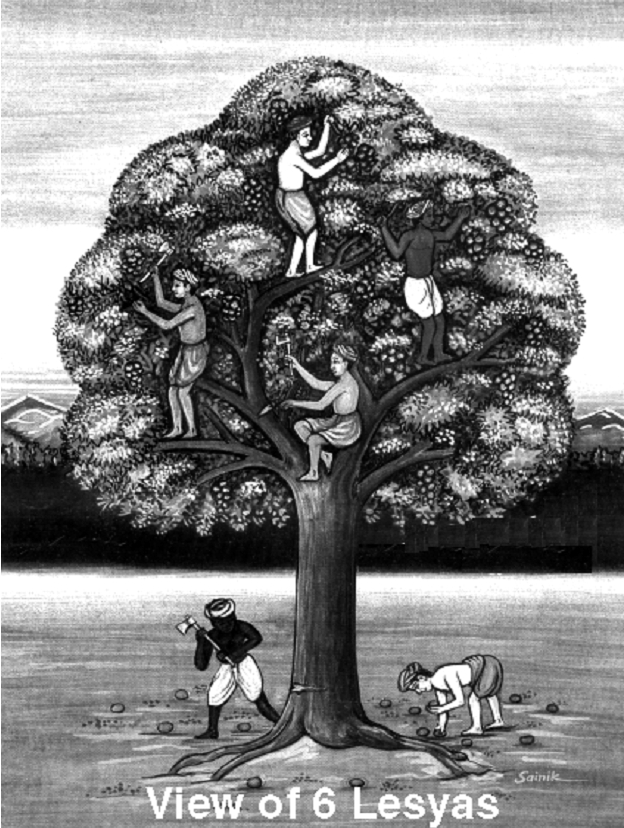One of the important concepts of Jaina doctrine of karma is that of leśyā. It is difficult to translate this word into English. Though it is generally translated as 'tint' and 'colouration'. The mental, vocal or bodily tendency of a being saturated by passions is called leśyā. In the scriptures six types of leśyās are discussed in such a fashion as to give the impression of their being six colours:
1 Black leśyā Unholy (aśubha) 2 Blue leśyā Unholy (aśubha) 3 Grey leśyā Unholy (aśubha) 4 Red leśyā Holy (śubha) 5 Yellow leśyā Holy (śubha) 6 White leśyā Holy (śubha). The unholy leśyās produce miserable course of life of a jīva and the holy leśyās bring happy course of life of a jīva.[44] According to Herman Jacobi, the word leśyā is derived from kleśa which effets the self like the alteration on a crystal by putting coloured things on it.[45] Those activities by which the self is associated with karma are called leśyā. The relation between karma and self is called leśyā.[46] It is said that the self is tained or identified with merit (puṇya) and demerit (pāpa) and this taint is known as leśyā.[47] It arises from yoga i.e. the activities of mind, body and speech with the application of four passions as follows:
- Anger,
- Pride,
- Deceit
- Greed.[48]
There are two types of leśyās:
- Dravya leśyā,
- Bhāva leśyā.[49]
- Dravya leśyā
That which is produced by the body (nāma karma) is called dravya leśyā.[50] The colours of the body through which it is produced by nama-karma is known as dravya leśyā.[51] The six leśyās having different colours are stated as dravya leśyā.
- Bhāva leśyā
The activity of mind, body and speech mixed with passions is called bhāva-leśyā.[52] The feeling of the self on account of the rise, suppression, mixed suppression and annihilation of mohaniyākarma is called bhāva-lesya.[53]
The nature of leśyā is explained in a parable famous in Jainism:Six men went to a forest. They saw a mango tree full of fruits. Everyone wanted to eat the mangoes:

In buddhism too the doctrine of karma is associated with the type of colours. There are four colours:
- Black (aśubha)
- White (śubha)
- Black and white (aśubha and śubha)
- Not black not white (not śubha not aśubha).[54]
The six leśyās are the colours of aura of the human body in occult Jainism. The theosophical view of the colours of the aura may be compared - the aura of the saint is ethereal-bluish, like the shimmering blue of pure white ice, that of the angry man is red, that of wicked and sinful man is black and so on.[55]
The doctrine of karma is logically related with the concept of leśyās an they have a moral bearing. Dr. Radhākṛṣṇā observes - Connected with the karma theory is the doctrine of leśyās which are of six types. The totality of karmas taken up by a soul induces in it a transcendental colour or complexion, which cannot be perceived by the naked eyes. The state of soul is produced by its inborn nature and the karma with which it is associated. Each kind of karma has its predestined limits with in which it must be purged off.[56]
 Prof. Dr. Sohan Raj Tater
Prof. Dr. Sohan Raj Tater
 Doctoral Thesis, JVBU
Doctoral Thesis, JVBU